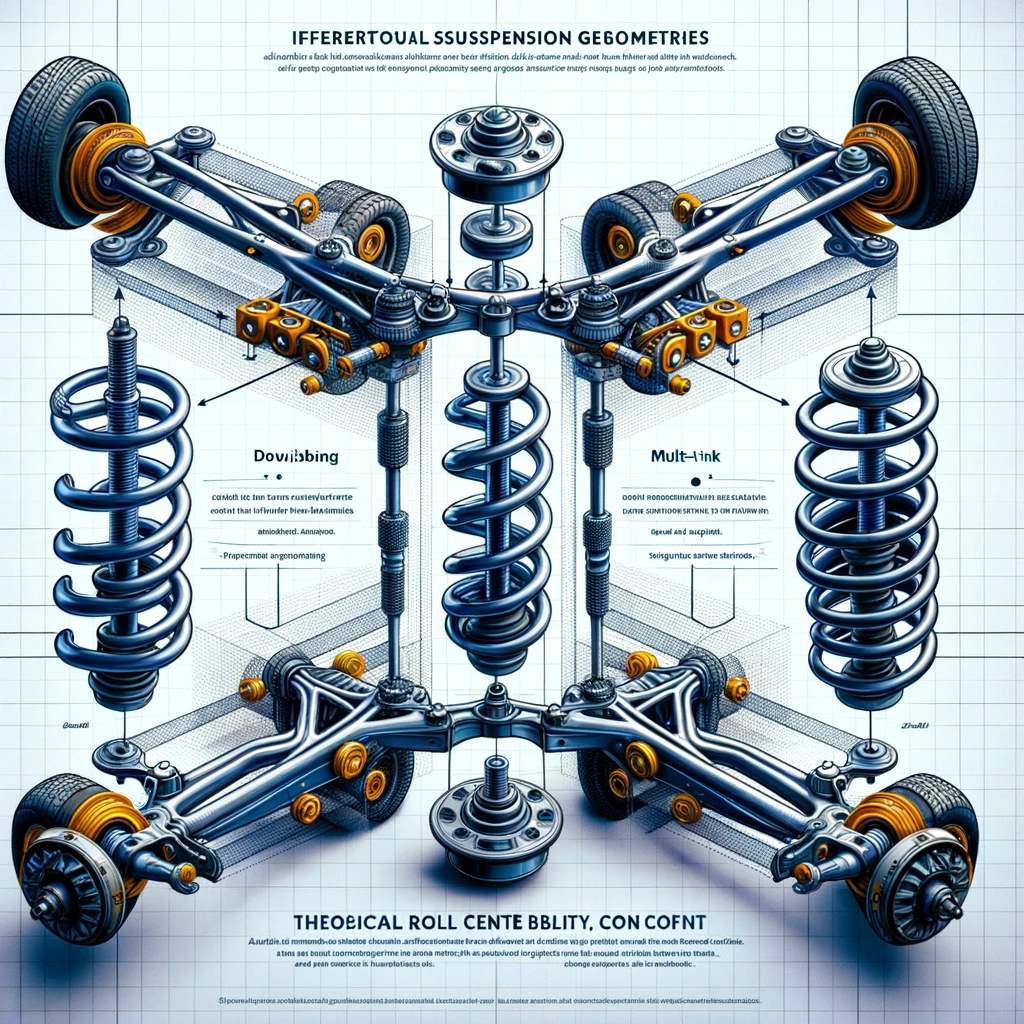How to Locate the Roll Center in a Car: A Comprehensive Guide
Understanding Roll Center
The roll center is an imaginary point in a vehicle’s suspension system that plays a critical role in its handling characteristics. It’s where the lateral forces in cornering are reacted to by the vehicle’s suspension. The position of the roll center, both in height and laterally, greatly influences the vehicle’s stability, cornering, and overall handling performance. A well-positioned roll center minimizes undesirable body roll, ensuring the tires maintain optimal contact with the road surface, thus enhancing safety and driver control. Fore more articles about Motorsport Mechanics see also our section.

Basic Concepts of Roll Center
The foundation of locating the roll center is rooted in the concept of the instantaneous center of rotation—a point that symbolizes the pivot around which a component rotates. For a vehicle’s suspension system, this involves the application of geometric principles to determine the roll center by examining the movement of suspension links in relation to the chassis.
Determining Roll Center in Independent Suspension Systems
Independent suspension systems allow each wheel to move independently, offering superior handling and comfort. Identifying the roll center in these systems involves pinpointing the centers of instantaneous rotation for the wheels and linking these points to their corresponding tire contact patches.
Step-by-Step Guide to Locating Roll Center
- Identifying the Center of Instantaneous Rotation: Begin by extending the lines of the suspension arms to their intersection, defining the center of rotation for the wheel relative to the chassis.
- Calculating Roll Center for Different Suspension Types: The roll center is located by drawing lines from the instantaneous centers of rotation to the tire contact points. The intersection of these lines determines the roll center’s position.
Analysis of Roll Center Positioning
The height and lateral placement of the roll center directly affect vehicle dynamics. Adjusting the suspension arms’ inclination allows for the manipulation of the roll center height, tailoring the vehicle’s handling to specific requirements.

Practical Examples of Roll Center Adjustment
Through examples such as adjustments in a transverse quadrilateral suspension, we illustrate how altering suspension component geometry can modify the roll center’s height, influencing the vehicle’s handling characteristics.
Roll Center in MacPherson Suspension Systems
The MacPherson strut suspension, prevalent in many contemporary vehicles, poses unique challenges in roll center adjustment. This section outlines the procedure for locating the roll center in MacPherson setups, emphasizing the influence of suspension geometry on handling.
Advanced Techniques for Roll Center Determination
For precise roll center determination, advanced techniques involving computational simulations and experimental frameworks are employed. These methods allow for refined suspension design optimizations, catering to specific handling preferences.
Troubleshooting Common Roll Center Issues
Incorrect roll center positioning can lead to handling deficiencies. Here, we provide strategies for diagnosing and rectifying roll center-related problems to enhance vehicle stability and handling.
Innovations in Roll Center Design and Adjustment
Exploring the latest in suspension technology, this section delves into innovative approaches to roll center optimization, highlighting their potential to redefine future vehicle dynamics.
Comparative Analysis of Roll Center Across Different Vehicle Types
The requirement for specific roll center characteristics varies significantly across different vehicle categories. This analysis contrasts roll center considerations in racing cars, passenger vehicles, and off-road vehicles, underscoring the importance of customized suspension design.
Safety Considerations in Roll Center Design
The strategic placement of the roll center is vital for vehicle safety, particularly in mitigating rollover risks. This segment discusses the interplay between roll center positioning and vehicle safety, alongside relevant design standards.
Roll Center Adjustment in Aftermarket Tuning
For automotive enthusiasts keen on refining their vehicle’s handling through suspension modifications, this section outlines best practices for roll center adjustment, supported by real-world case studies from the racing circuit.

Educational Resources for Further Learning
Concluding the guide, we recommend a collection of resources for those interested in deepening their understanding of suspension design and roll center dynamics, including books, online courses, and community forums.
FAQs
- What is the roll center in a car? The roll center is a theoretical point in a vehicle’s suspension system around which the car’s chassis rolls during cornering. Its optimal positioning is crucial for balanced handling and stability.
- Why is the roll center position important? The position of the roll center affects the vehicle’s body roll, tire contact with the road, and overall handling. Properly located, it enhances stability and cornering performance.
- How do you find the roll center in an independent suspension system? Locating the roll center involves identifying the instantaneous centers of rotation for the wheels and linking these points to the tire contact patches. The intersection of these lines determines the roll center.
- Can the roll center be adjusted? Yes, adjusting the geometry of suspension components, such as the inclination of arms, can alter the roll center’s height and position, affecting handling characteristics.
- What challenges are associated with MacPherson suspension systems in roll center adjustment? The MacPherson strut suspension, lacking an upper control arm, limits the adjustability of the roll center. However, strategic modifications can still influence its position to improve handling.
Conclusion
Mastering the intricacies of roll center positioning unlocks a new realm of vehicle handling and performance optimization. Whether for professional racing, automotive engineering, or enthusiast tuning, understanding and applying the principles outlined in this guide can dramatically enhance a vehicle’s dynamic capabilities. As suspension technologies evolve, so too will the methodologies for roll center determination, promising even greater advancements in automotive performance and safety.


